


Likewise, QFD’s most essential stage, House of Quality, is one of the most technical stages in the process. Hence, it’s needless to say that it’s a comprehensive methodology, and not to mention it’s aligned with an organization’s quality management system. Each phase entails a variety of elements, steps, requirements, and activities to establish the right foundation for implementation.

The QFD process involves four stages: Product Planning, Product Development, Process Planning, and Production Planning.
how iAuditor can help you generate efficient HoQ templates.īenefits of Using a House of Quality Template. a House of Quality template example and. the benefits of using a House of Quality template. You can also update the data source by change the shape data in your drawing.House of Quality Template | iAuditor by Safet圜ulture Once the Database Wizard has been completed you can then add your shapes to the drawing and Visio will prompt you to select a record to assign to the shape.įrom 09:55 the video explains how to update your shape data when the underlying data is changed. Select the shape that you want to link to a record in your database and then start the Database Wizard – see this in the video starting at 04:20. You cannot link your data source to the shapes in the stencils that Visio provides, but you can link your data to a shape that appears in your Document Stencil. The process is explained in the video start at 01:15.The ODBC source is set up in the Administrative Tools. The next step is to set up an ODBC data source in the control panel, this will enable us to create a connection between your Excel database and the Visio drawing. If you are not sure how naming works watch the video – it shows the process pretty clearly and just requires a few steps, starting at 00:33. Naming is just another way of referring to a range of cells. Another important part of the database design is that you will to need to name your database.







 0 kommentar(er)
0 kommentar(er)
